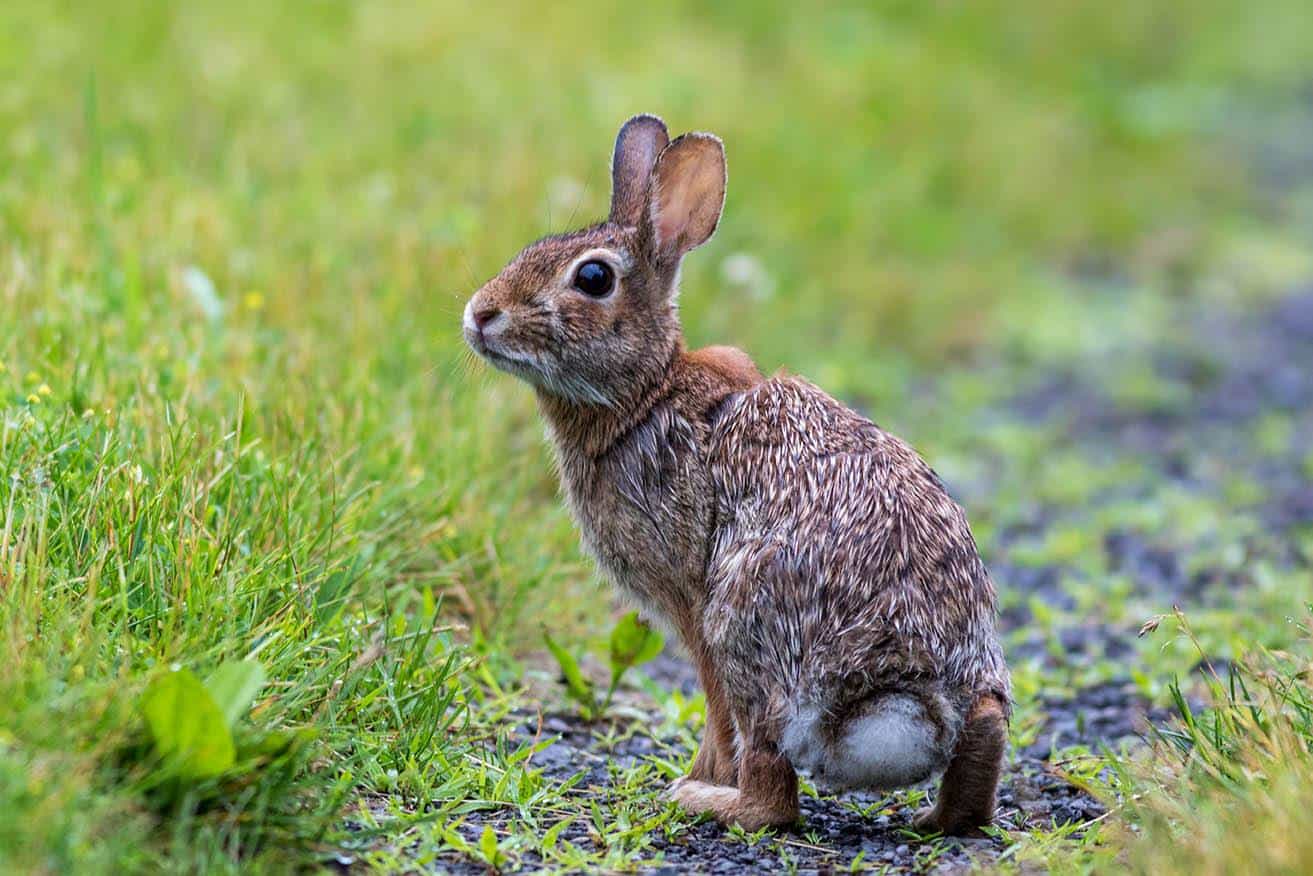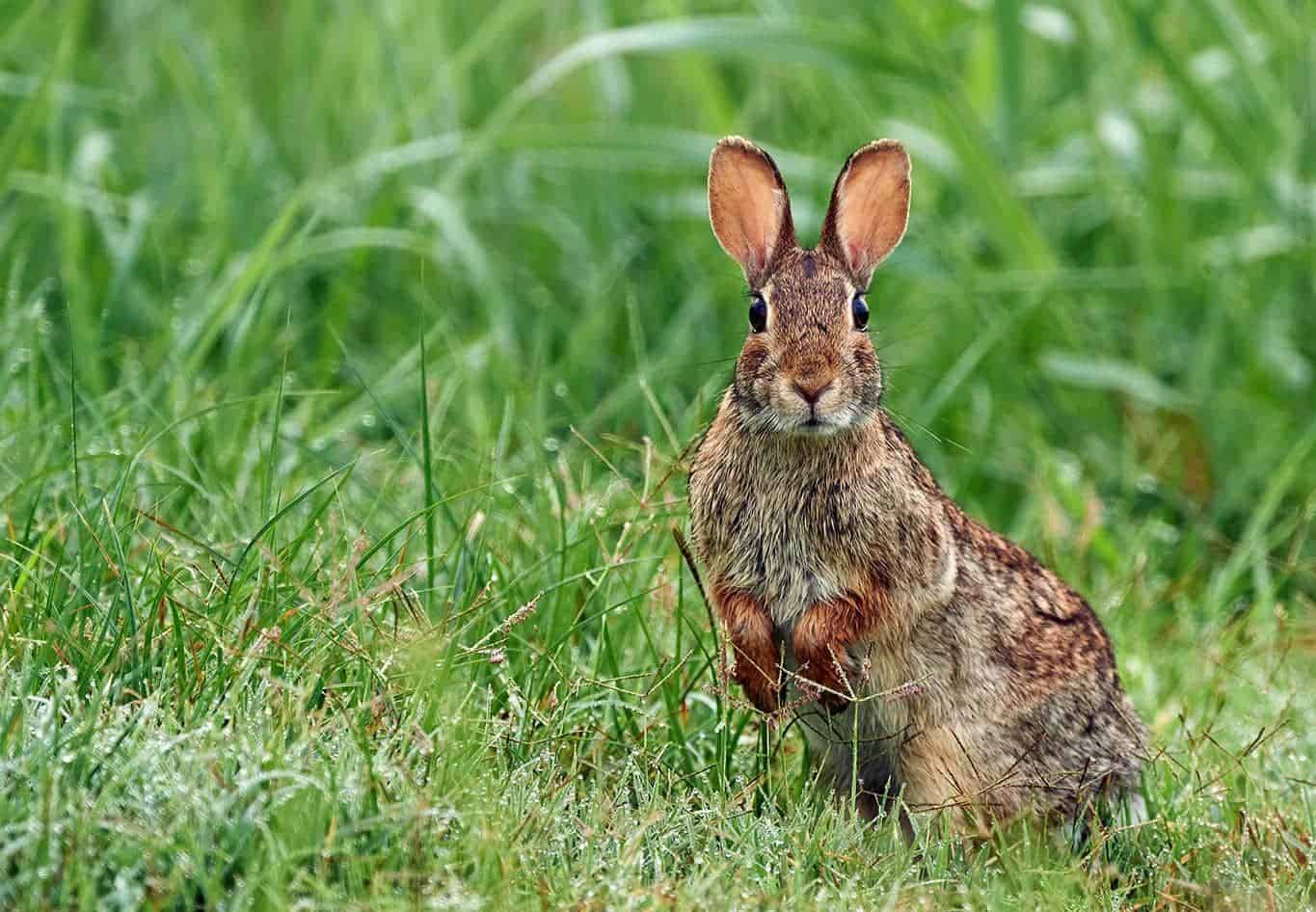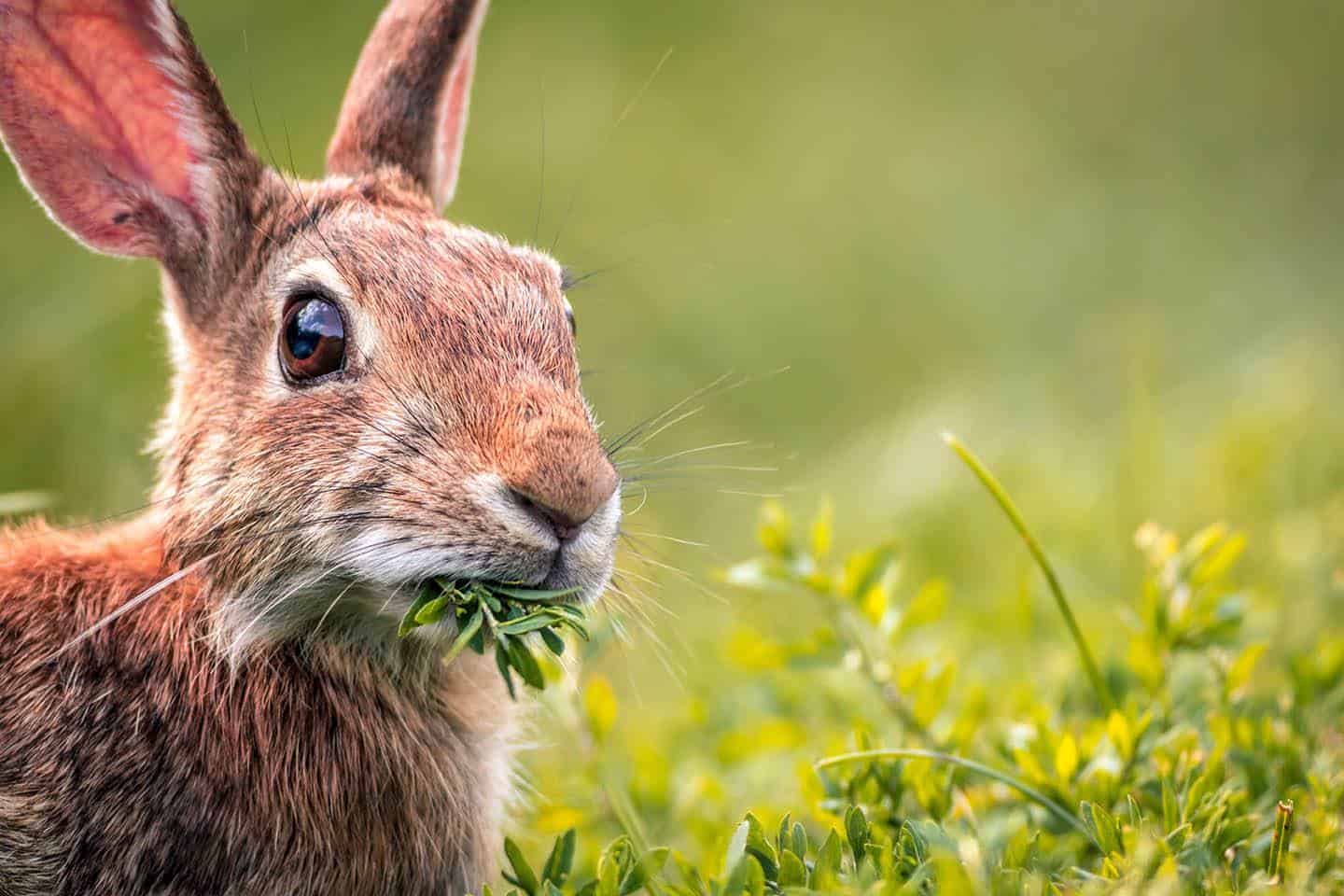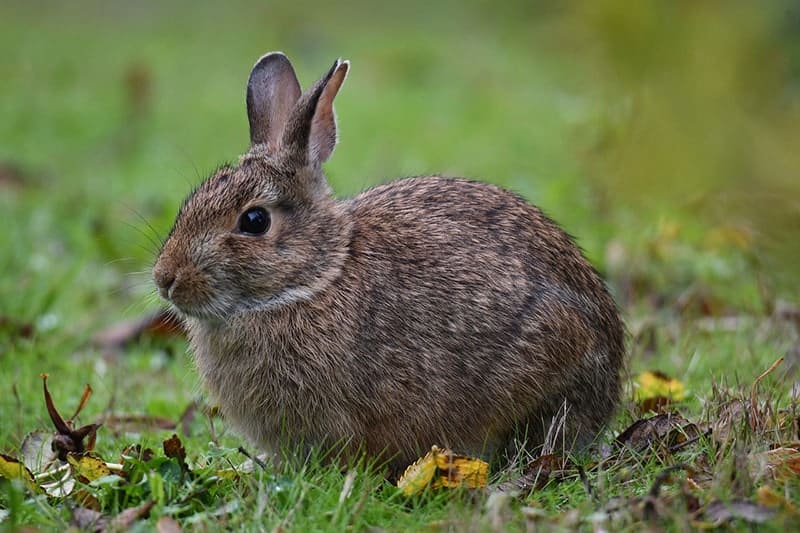The Eastern Cottontail Rabbit (Sylviagus floridanus) is a wild species of lagomorph found across the United States, stretching from Canada through the US to northern South America. These wild rabbits are commonly seen hopping around lawns or yards in the early morning or late evening, foraging, and on the lookout for predators. In this article, we’ll discuss everything there is to know about the Eastern Cottontail Rabbit and what made them the most common rabbit species in America.
| Size: | Small |
| Weight: | 1.5lbs–3.5lbs |
| Lifespan: | 1–5 years |
| Similar Breeds: | Desert Cottontail, Mountain Cottontail, Brush Rabbit |
| Suitable for: | Living in the wild, not suitable as pets, don’t fare well in captivity |
| Temperament: | Nervous, solitary, territorial, wild |
Eastern Cottontail Rabbits are very successful lagomorphs belonging to the New World Cottontail group of rabbits (Leporidae) that live predominantly in the Midwest. Unfortunately, these wild rabbits cannot be kept as pets as they are not used to humans. The difference between the Eastern Cottontail Rabbit and the pet rabbit you’d find in the store (Oryctolagus cuniculus) is that the Eastern Cottontail Rabbit has never been domesticated. In contrast, pet rabbits have been accustomed to humans for hundreds (possibly thousands) of years. Because of this lack of domestication, the Eastern Cottontail Rabbit cannot be kept as a pet.
Eastern Cottontail Rabbit Characteristics
[yasr_multiset setid=7]
Temperament & Intelligence of the Eastern Cottontail Rabbit
The Eastern Cottontail Rabbit must be quick, smart, and savvy to survive the brutal reality of the wild. They often have very short lives (sometimes less than a year), but they breed prolifically and have an arsenal of tricks to help them thrive. They must be able to predict the movements of predators and successfully evade them to survive. This denotes intelligence, as does the Eastern Cottontail’s tendency to play with other rabbits during brief interactions.
Usually, the rabbits are very territorial and will defend their patch to the death, fighting up on their hind legs in a move called “boxing.” In addition, they are loners that don’t form social groups like many other rabbits do (including domesticated rabbits). The Eastern Cottontail Rabbit prefers being solitary and will spend most of its life this way, only meeting up during chance encounters to play and when mate.

Can Eastern Cottontail Rabbits be Kept as Pets?
The Eastern Cottontail Rabbit doesn’t make a good pet, and they shouldn’t be kept in captivity by anyone who isn’t a licensed wildlife rehabilitation center. Eastern Cottontail rabbits are wild animals and are different from pet rabbits; even wild rabbits that used to live in homes come from a line of domesticated rabbits bred to co-exist with humans.
Eastern Cottontails have never been domesticated and are incredibly fearful of humans, so keeping them in a cage and exposing them to human presence is terrifying and stressful. The best way to enjoy the Eastern Cottontail is to watch them from afar in their natural habitat.
Does This Rabbit Get Along With Other Animals?
The Eastern Cottontail is fiercely territorial and does not tolerate other animals well, even others of its species. The presence of another pet, such as a cat or dog, is most likely going to trigger an Eastern Cottontail’s fight or flight response, which will end one of two ways:
- Flight: The Eastern Cottontail will run, flashing its namesake white tail as a dazzling distraction as it zig-zags away.
- Fight: If escape is not an option, the Eastern Cottontail will use its claws and teeth to bite, scratch, and kick at any threats.
Eastern Cottontails are a prey species, and they get hunted by foxes, coyotes, lynxes, and even other domesticated cats and dogs in the wild. Because of this, no amount of introductions or training would help an Eastern Cottontail tolerate being around another pet. Rabbits also suffer from severe effects from stress, so forcing an Eastern cottontail Rabbit to meet a household pet may give it a heart attack and kill it on the spot.


Things to Know About Eastern Cottontail Rabbits
The first thing to remember is that Eastern Cottontail Rabbits are not pets and cannot be owned. Owning wild animals is illegal in many states, and the possibility of injury to yourself or the animal, the spread of disease, property damage, and other factors make them suitable only for the wild.
Food & Diet
The Eastern Cottontail Rabbit has a varied diet in the wild. They are similar to domesticated rabbits because they’re herbivorous, only eating plant material and fiber. The Eastern Cottontails’ diet will differ due to the seasons and what’s available, with most of their diet year-round comprising fibrous material like grasses and dandelions. They will eat their own partially digested feces (caecotrophs), like domestic rabbits do, to help them get every ounce of nutrition possible from their food.
Eastern Cottontails will eat a wide variety of fibrous materials in the summer, such as:
- Grasses like bluegrass or wild rye
- Clover
- Wild Strawberries
- Garden vegetables and herbs
In the winter, when the grass dies off, and snow covers the ground, these resourceful rabbits turn to trees to give them a meal. The bark and twigs of many trees can sustain the Eastern Cottontail over winter, such as Dogwood, Birch, Oak, Maple, and Sumac trees.

Habitat
Eastern Cottontails have a home territory of around 5 to 8 acres which they stay in for most of their lives, defending it against potential rivals. Males have a larger territory than females, particularly during the breeding season. They are crepuscular animals that are most active during dawn and dusk.
Unlike other species, the Eastern Cottontail does not dig burrows to reside in. Instead, they prefer to dig out or find hollows under piles of brush or logs. They will sit in these hides during the day, sleeping and grooming themselves before coming out as the daylight fades.
Eastern Cottontails prefer staying in a covered area next to a more open patch of land, such as hedgerows or woodlots. That is why they’re often found at the edges of lawns or vegetable patches; the Eastern Cottontail can be invasive and cause considerable damage to gardens and landscaped plants.
Exercise & Sleeping Needs
The Eastern Cottontail Rabbit is not an especially active species. They don’t venture too far from cover and stick to the edges of lawns or other open areas to forage. However, breeding seasons can bring about a change in this behavior and make them much more active!
Breeding season is from February to September each year, and males will seek out females to begin mating rituals that ratchet up the physical activity of the species. First, male Eastern Cottontail Rabbits will chase the females, pestering them until they agree to “spar” with them. Then, the rabbits will face each other and rise up on their hind legs, “boxing” and striking at each other with their front paws until they both jump up to 2 feet into the air! Once the rabbits have jumped, mating begins.
All exercise and activity (including the mating ritual described above) the Eastern Cottontail undertakes is done during the night as they are crepuscular/ nocturnal animals. During the day, they sleep within hides found under tree stumps or grassy mounds.

Lifespan and Health Conditions
Unfortunately, the Eastern Cottontail Rabbit has a very short lifespan compared to pet rabbits. Life as a prey species is fraught with danger, and the average lifespan for one of these rabbits is around 1 to 5 years. This is raised to nine years in captivity, likely because of the protection from diseases and predation. Many factors can affect a wild rabbit’s lifespan, including:
- Predation by hawks, owls, foxes, Lynx, Coyotes, and humans
- Extreme temperatures
- Stress
- Diseases
- Physical injury
- Available food
Several known conditions can affect Eastern Cottontails, some of which can be spread to pet rabbits and even humans if they come into contact with them.
- Mange
- Rabbit Fibroma Disease
- Malnutrition
- Tularemia
- Myxomatosis
- Viral Hemorrhagic Disease
Male vs Female
There are few differences between male and female Eastern Cottontails, namely in size. Females are slightly larger than males, weighing up to 3.4 lbs.


3 Little-Known Facts About Eastern Cottontail Rabbit
1. Eastern Cottontails Are Named After the Distinctive White Fur on the Underside of Their Tails
The white underside of an Eastern Cottontail’s tail starkly contrasts the brown-grey fur on the rest of its body. The white hair is thought to confuse and entrance chasing predators, allowing the rabbits to run to safety.
2. They Have Large Eyes That Protrude Slightly Out of Their Heads, Which Gives Them Nearly 360-Degree Vision. Perfect for Spotting Predators!
While the Eastern Cottontail has an excellent view of the entire body, they have a blind spot right in front of their noses, similar to domestic rabbits.
3. Eastern Cottontails Can Run at Speeds Up to 18 Miles per Hour for as Long as a Half Mile
This feat is amazing in itself, but Eastern Cottontails also run in a hectic, zig-zag motion to deceive prey, meaning the energy expenditure for this feat of endurance is massive!

Final Thoughts
The Eastern Cottontail is a common sight in the US, and the species has become the country’s most common wild rabbit species. They’re prolific breeders and amazing escape artists that dash away from their many predators with speed and grace. However, they are very different from their domesticated bunny cousins, and the Eastern Cottontail cannot be kept as a pet. It is illegal in most states to own a wild animal without a license, and Eastern Cottontails do very poorly in captivity. You can still enjoy these cute little rabbits in their natural habitat by watching them hop across lawns at dawn and dusk.
Featured Image Credit: Veronika Andrews, Pixabay
